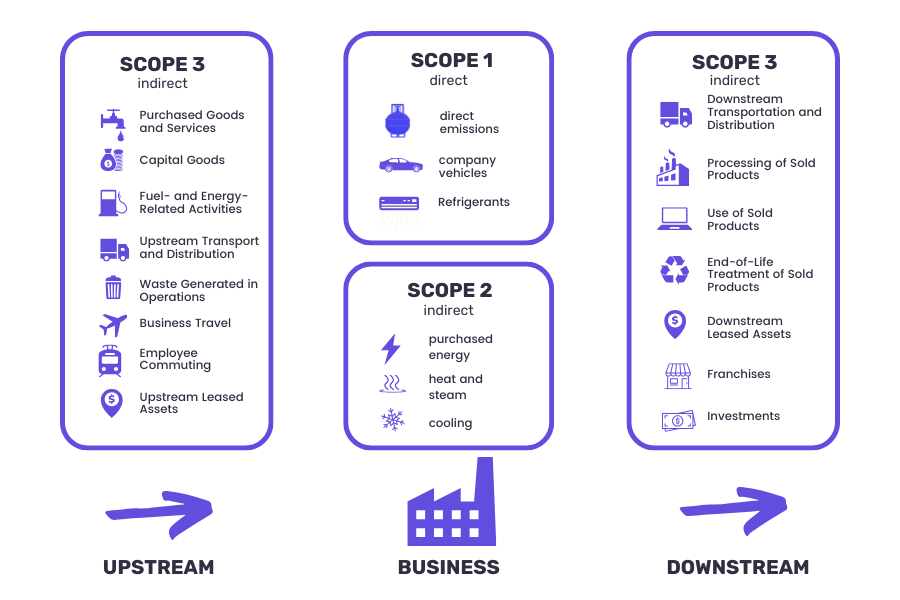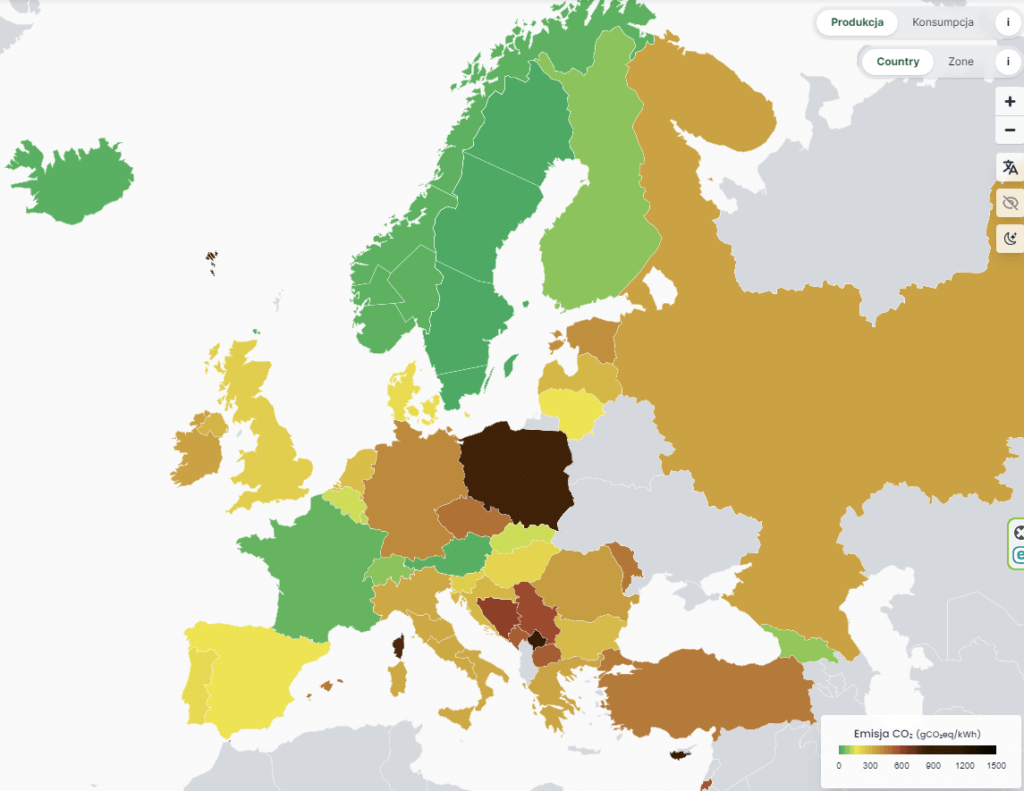What is Scope 3 in the organization’s carbon footprint calculation?

Companies are increasingly trying to analyze and manage emissions, as they often have a significant impact on an organization’s total carbon footprint and can be an important area for achieving sustainability goals. Scope 3 of an organization’s CO2 emissions causes a lot of trouble for businesses and makes emissions reporting complicated. It stems from a company’s supply chain, and for many companies, it often accounts for more than 70% of their emissions. Read the article and learn what you need to know while reporting your organization’s carbon footprint and how this measure helps your company become climate-neutral.
Table of content
More accurate reporting = more effective reduction of greenhouse gas emissions
According to Boston Consulting Group study, companies that measure their carbon footprint (carbon dioxide, nitrous oxide, and other greenhouse gases) in all 3 scopes see a higher decrease in greenhouse gas emissions – that is, the more accurate the reporting, the more effective the reduction.
The same study found that companies and organizations that have automated digital solutions for measuring emissions are more than twice as likely to measure greenhouse gas emissions comprehensively.
Charlotte Degot, CO2 AI expert at BCG, confirms, “Supporting digital tools in this process gives accuracy and comprehensiveness to the data and ultimately helps companies make decisions on reductions”.
With existing automated tools on the market, businesses get comprehensive knowledge in one place. With all the metrics, legislation, and complex European Union standards built into the carbon footprint counting software, the person reporting doesn’t need to have ESG background knowledge at all.
What are Scope 1, 2, and 3 carbon footprints?
Scope 1, Scope 2, and Scope 3 are categories used to classify and measure various sources of greenhouse gas emissions in the context of a company or organization’s carbon footprint. These scopes were developed by the GHG Protocol (Greenhouse Gas Protocol), a widely accepted standard for measuring and managing GHG emissions. To summarize:
Scope 1 – all greenhouse gas emissions that take place in a company – direct emissions.
Scope 2 – indirect emissions from the purchase of electricity and heat.
Scope 3 – indirect emissions from the entire supply chain.

What falls under Scope 1 greenhouse gas emissions?
Scope 1 emissions are those resulting from the combustion of fuels in vehicles, and stationary installations and also fugitive emissions resulting from, for example, the use of refrigerants in air conditioners. These emissions are usually under the direct control of the organization and result from sources that are owned or controlled by the organization.
Typical sources of emissions in this range include emissions from the combustion of fossil fuels in company-owned vehicles, heating systems, and manufacturing processes.
Scope 1 emissions are often the easiest to measure and manage because they are under the direct control of the organization.
What does Scope 2 mean in terms of calculating a company's carbon footprint?
Scope 2 emissions include indirect emissions resulting from the generation of electricity, heat, or process steam consumed by the organization. These emissions come from activities that are outside the organization’s direct control but are related to its energy consumption.
They are often classified as indirect emissions because they arise from the production of energy used by the organization, and are necessary to purchase for production processes. Organizations can reduce Scope 2 emissions by switching to cleaner and more sustainable energy sources, such as renewable energy or purchasing renewable energy certificates.
Location based vs market based - which methodology is better?
Scope 2 accounting methods are “allocation” methods – assigning emissions from the generators to end users. GHG Protocol imposes reporting on companies:
- location-based method – based on GHG emissions produced within a country’s area, both electricity production and consumption
- market-based method – companies’ individual choices of electricity product or supplier
Market-based methodology (emitting electricity from suppliers of that electricity) is more favorable than location-based – the national data for Poland is unfavorable (chart below).

In Scope 1 and 2, we collect quantitative data (liters, kilograms, tons, kilowatt-hours, gigajoules), not financial data – only this way of reporting will allow us to know a reliable result.
What is Scope 3 for reporting and calculating CO2 emissions?
Scope 3 so-called Scope 3 is all indirect emissions, along the entire value chain of the company. It is often necessary to obtain information on emissions from contractors, and suppliers, but time spent on collecting this data will pay off with an accurate calculation of the carbon footprint.
Scope 3 scares entrepreneurs. They are unsure how they should report each category, how to define “other” or have doubts about whether their company is affected by a particular category. As experts, we are well aware of this, which is why we have created a tool that will dispel these doubts once and for all and allow you to count your entire carbon footprint yourself.
Scope 3 - Greenhouse gas emissions reporting categories
What CO2 emissions reporting categories are included in Scope 3? It is worth noting that the scope and detail of Scope 3 emissions reporting may vary depending on the organization and its specific activities and priorities for reducing greenhouse gas emissions.
Scope 3 is 15 different categories divided into 2 groups. See below for what is included in each category:
Upstream – that is, those emissions that, along with Scope 1 and Scope 2, are generated until the finished product is produced, along with logistics, business travel; purchased raw materials and services (e.g., office equipment, water, waste generated from production, etc.):
- Capital goods
- Emissions related to energy and fuels not included in Scope 1 and 2
- Transportation and distribution conducted by vehicles or equipment not owned or controlled by the organization;
- Waste disposal – includes emissions from waste disposal processes, including incineration and landfilling.
- Business travel emissions – emissions related to employee travel, such as airplane flights, business trips by car, train, or other modes of transportation.
- Employee commuting – this refers to emissions related to employee travel to the workplace, such as commuting by private car, bicycle, or using public transportation
- Rented assets not covered by Scope 1 and 2 – the carbon footprint from operating them
Downstream – that is, the emissions associated with the continued life of a product, its transportation, use, and how waste will be disposed of afterward.
- Transportation and distribution of products;
- Product processing and what happens to sold products
- Product use – resulting from the use of products by customers, including the energy consumption of electronic devices or household appliances.
- Handling of sold products after consumption;
- Franchises;
- Investments – refers to emissions related to the company’s investments
- Other organization-specific sources of greenhouse gas emissions that do not fall under Scope 1 and 2
Is carbon footprint calculation in Scope 3 mandatory?
According to the latest European Commission regulations, under the CSRD, carbon footprint reporting in the annual ESG report will become mandatory for all 3 scopes of emissions. Importantly, addressing the challenge of calculating the carbon footprint across all scopes is the most effective way to reduce carbon emissions.
Businesses are apprehensive about scope 3 reporting, as it is very extensive, covers many indirect emissions, and needs to be tailored to the specifics of a particular company. They often choose consultants because they don’t know that scope three can also be calculated with an automated tool. You only need to define the categories once and later, filling in the data yourself will be much easier.
A prerequisite for the success of this process is to calculate the carbon footprint in software that guarantees compliance with the GHG Protocol, the ISO 14064-1 standard, and the GRI and TCFD standards. An example of such a tool is the Plan Be Eco tool, which meets all the standards.

Benefits of calculating an organization's Scope 3 carbon footprint
It is worth understanding that the scope three carbon footprint is not intended to make life difficult for businesses on the road to sustainability. It is also worth treating it as an analytical tool that will show the processes that are beneficial (or not) for the company’s development.
What we can learn by counting an organization’s carbon footprint:
- Identifying the largest sources of emissions
- Optimization of the supply chain
- Better understanding of the company’s climate impact
- Reducing costs by reviewing production processes and suppliers
- Development and introduction of innovations
- Increasing credibility among investors, customers, and stakeholders
- Improved employee relations (education, culture of sustainability)
Automate the calculation of an organization's carbon footprint
With the Plan Be Eco tool, any business can calculate their organization’s carbon footprint in all three scopes in a fast and automated way. By calculating your carbon footprint with the help of a dedicated tool, you save money, time, and energy, while being sure that the resulting calculations are accurate and in line with European Commission guidelines.
Importantly, by using the Plan Be Eco tool, you can decide for yourself when to complete the carbon footprint data, and receive support when you need it, adjusting the activities to your work schedule. The emissions management process is fully under your control!

Online support at every stage of the calculation
You no longer have to worry about the difficulties of calculating CO2 emissions. Plan Be Eco has created a tool that will help you go through the process step by step, including for indirectly generated Scope 3 emissions.
We know that support is very important for our customers, so we guarantee it at every stage of the calculation – not only technical support, but also substantive support from our ESG experts. We give constant access to knowledge, expert articles on our blog, and consultation opportunities.
We also offer webinars and workshops, and our clients will be the first to hear about them. The knowledge contained therein cannot be found in open, free articles – we are committed to educating our clients (including future ones) so that they can report GHG emissions properly, for the good of their business and the planet.
Customize the tool to your company's specifications
Entrepreneurs may be worried that standard carbon footprint reporting tools don’t fit their company or don’t include Scope 3. At Plan Be Eco, each client has the option of innovative customization. This involves analyzing the exact case of our client’s company and creating a personalized path, tailored to your unique needs and business characteristics.
Customization takes a while – from 15 minutes to a maximum of one business day. Much depends on the structure of the company, the number of subsidiaries, the number of products sold, or the individual needs of the organization. With this solution, clients gain precise calculations, accurate reports, and the assurance that they have their carbon footprint under control.
Scope 3 in the tool offered by Plan Be Eco is tailored to the specifics of the company and the emissions produced throughout the supply chain.
Pay once, and use as much as you want!
Calculating and reporting your carbon footprint across the value chain is easy – you pay only once per year and then have full 12-month access to the Plan Be Eco tool. You use it according to your schedule and needs. ️
The carbon footprint is calculated automatically when you enter your data – the result also depends on your involvement. The more accurately you complete the data from the three scopes, the more reliable the result you will get for your enterprise and the closer you will get to climate neutrality.
It’s best to enter the invoice data necessary for emissions reporting into the carbon footprint calculating system once a month, just as they go out to accounting – it will save your work at the end of the accounting year.
Do I have enough data to start calculating Scope 3?
Yes, as long as you have invoices for your company’s operations! Our system allows you to calculate the carbon footprint both through the method of quantitative indicators (i.e. kg of raw material purchased, for example) and the method of so-called spend-based – the amount of money spent on a product, or service.
The latter method should be used only when we do not know the carbon footprint of the purchased product (it is worth asking manufacturers), or when we do not have complete information on the amount of intermediate products necessary to calculate the value of emissions.

With the Plan Be Eco tool, you don’t have to worry about recalculation – everything happens automatically when you enter the quantity data from your invoices. We’ve sewn the exact metrics and methods into our calculator, making it GHG Protocol compliant.
Click here to start your journey to corporate climate neutrality! Still in doubt? Read on and see how easy it is to count and report CO2 emissions with our tool.
Greenhouse gas emissions - calculating is easier than you think
Scope 1 and 2 emissions are considered an organization’s primary responsibility, while Scope 3 emissions are seen as a broader responsibility that requires the cooperation and involvement of external parties. Many organizations are looking to measure and reduce all three scopes of emissions to achieve comprehensive carbon reduction goals and effectively address their environmental impact.
With the growing interest in sustainability, companies are realizing that analyzing and managing emissions is a key part of their strategy. With increasingly sophisticated tools and technologies, determining these emissions across a company’s value chain is becoming more precise and accessible.
Managing emissions, an organization’s carbon footprint, has never been simpler – such an intuitive tool, compliant with the GHG Protocol and including Scope 3 is a big help to an organization’s operations in the process of reducing greenhouse gas emissions. The Plan Be Eco is a facilitation of companies’ sustainability work.
Summary
Today’s companies increasingly understand that responsibility for climate change and reducing greenhouse gas emissions also lies with them.The pursuit of sustainability has become not only a moral obligation, but also a strategic goal. Companies are taking a number of measures to reduce their environmental and social impact.
First and foremost, they are investing in technologies and processes that enable them to reduce greenhouse gas emissions, while implementing strategies that strive for climate neutrality. However, this is not the only sphere of their activities. Companies are increasingly adhering to corporate sustainability due diligence (e.g., by implementing the CSRD, which requires disclosure of non-financial information), engaging in ethical management practices and taking action on behalf of local communities.
In addition, corporate transparency and reporting have become an indispensable element to monitor progress on sustainability and inform stakeholders about the goals and challenges achieved. These activities point to the increasingly comprehensive role of companies in creating a society and economy based on sustainable development, in which care for the climate and environment is a key aspect of their business strategies.
Did you find the article interesting? Check out the rest of the content on our carbon footprint calculation blog here!

